Arizona tint laws were enacted in 1994, and they regulate the amount of light that passes through a car’s windows.
The law is intended to protect drivers, passengers, and law enforcement officers from dangerous situations that can arise from excessively tinted windows.
Regulations Regarding Window Tint in Arizona
The Arizona Tint laws regulate four types of car windows: the windshield, front side windows, back side windows, and rear windows.
Here are the regulations for each of these windows:
| Type of Window | Legal Tint Level | Medical Exemption Allowed | Reflective Tinting Allowed | Penalties for Violation |
|---|---|---|---|---|
| Windshield | 33% | No | 35% | $50-$115 (1st offense) |
| Front Side | 70% | Yes (with medical waiver) | No | $75-$190 (2nd offense) |
| Back Side | ANY | No | No | $300 + (3rd offense) |
| Rear Window | ANY | No | No |
Windshield
The windshield must allow at least 33% of light to pass through it.
The top five inches of the windshield can be tinted, but only if it does not obstruct the driver’s view.
Front Side Windows
The front side windows (driver and passenger side) must allow at least 70% of light to pass through them.
However, they can be tinted to a darker shade if the driver has a medical condition that requires protection from UV rays.
This exemption requires a medical waiver from a licensed physician.
Back Side Windows
The back side windows behind the driver and passenger can be tinted to any darkness level, as long as the vehicle has side mirrors.
Rear Window
The rear window can be tinted to any darkness level, as long as the vehicle has side mirrors.


Additional Regulations
Reflection
The law prohibits any tinting material that reflects more than 35% of light from the windshield or front side windows.
Medical Exemptions
If a driver has a medical condition that requires protection from UV rays, they can apply for a medical exemption.
The exemption requires a written recommendation from a licensed physician and must be carried in the car at all times.
Color Restrictions
Arizona does not regulate the color of the window tint.
Side Mirrors
If the back-side windows or rear windows are tinted, the vehicle must have side mirrors.
Exceptions to Legal Limits
As previously mentioned, medical exemptions are one exception to the legal tint limits.
Another exception is for vehicles that were originally manufactured with tinted windows.
These vehicles must meet the manufacturer’s original tinting specifications.
Penalties for Breaking the Law
Fines
If you violate Arizona’s tint laws, you will be subject to fines.
The amount of the fine depends on the number of previous convictions:
First Conviction
The first offense for violating Arizona tint laws is a civil traffic violation, and the fine can range from $50 to $115.
Second Conviction
The second offense is also a civil traffic violation, and the fine can range from $75 to $190.
Third Conviction
A third offense is a class 2 misdemeanor, and the fine can range from $150 to $2,500.
Other Penalties
In addition to fines, you may also be required to remove the illegal tint, and your car could be impounded.
You may also face points on your driver’s license, which can impact your insurance rates.
Penalties for Non-Compliance
If you are caught driving with illegally tinted windows, you will be required to remove the tint and bring your car into compliance with Arizona tint laws.
Once your car is compliant, you must have it inspected by a certified inspection station, and the station will provide you with an inspection certificate that you must carry in your car at all times.
Failure to comply with these regulations can result in additional fines and penalties.
Benefits of Legal Tint
While it may seem tempting to tint your windows darker than what is allowed by law, there are several benefits to following Arizona’s tint regulations.
For one, you will avoid legal issues and fines. Additionally, legal window tinting can provide significant benefits such as:
Privacy: Window tinting can provide a layer of privacy, making it more difficult for people to see inside your car.
UV Protection: Window tinting can block up to 99% of harmful UV rays, which can cause skin damage and increase the risk of skin cancer.
Reduced Glare: Window tinting can reduce glare from the sun and headlights, making it easier and safer to drive.
Improved Comfort: Window tinting can help regulate the temperature inside your car, making it more comfortable to drive in hot Arizona weather.
Enhanced Style: Legal window tinting can still give your car a sleek, stylish look without risking legal issues.
How to Get Your Car Tinted Legally in Arizona
To get your car tinted legally in Arizona, you must find a licensed and certified window tint installer.
These installers will know the state’s regulations and can help you choose a tint that is compliant and meets your needs.
Once your windows are tinted, you must make sure they meet Arizona’s regulations by having them inspected at a certified inspection station.
FAQ’s
What is the darkest legal tint in Arizona?
Any darkness on the back side windows and rear window, 33% on front side windows.
Can I do 20 tints in Arizona?
20% tint: Not legal on front side windows.
Is 30% tint legal in Arizona?
30% tint: Legal on back side windows and rear windows, but front side windows must allow at least 33% of light.
How much is a tint ticket in Arizona?
Fine ranges from $50-$115 for a first offense and up to $2,500 for a third offense.
References: